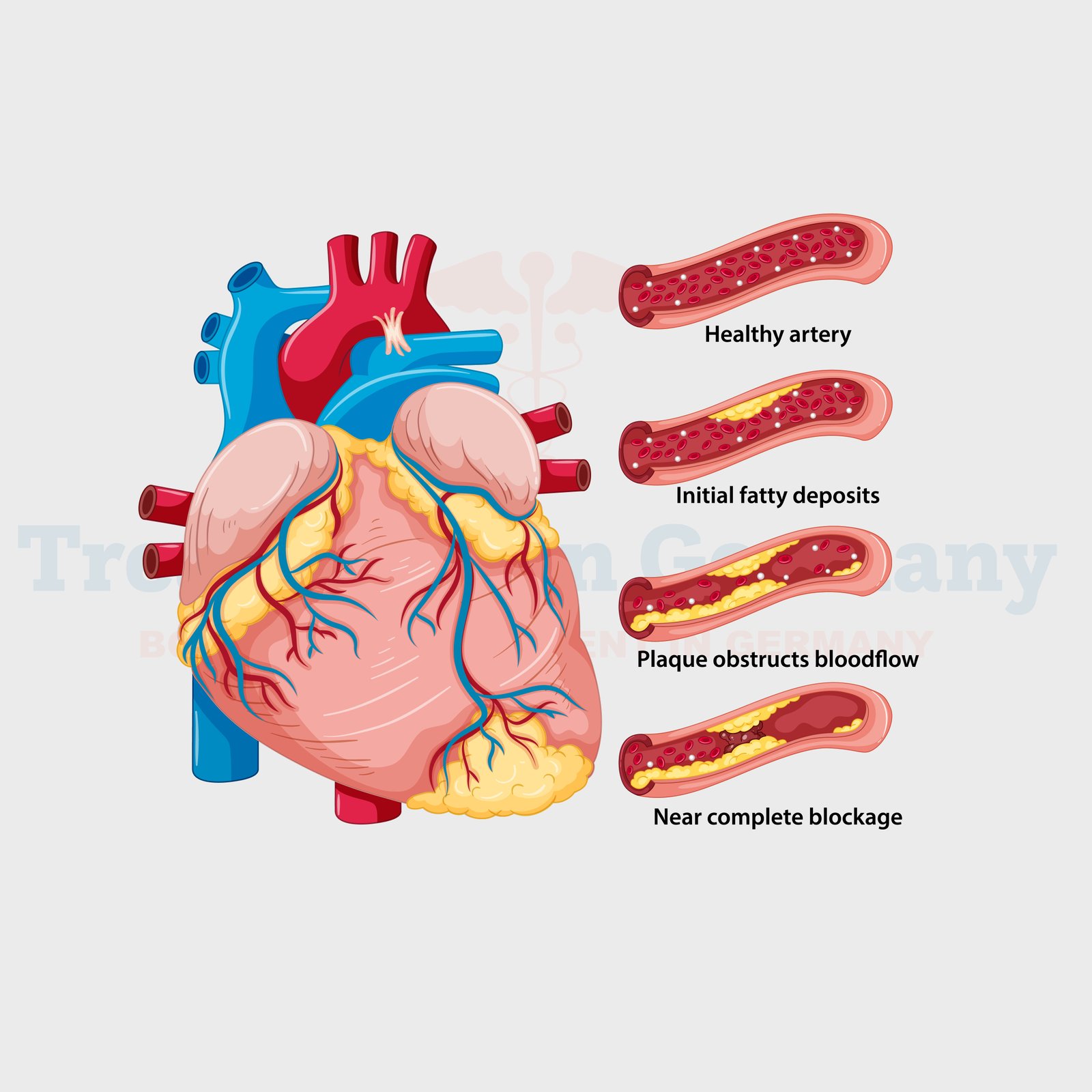Millions of people suffer from coronary artery disease. The process by which the coronary arteries that supply the heart with oxygen-rich blood narrow or obstruct because of plaque accumulation leads to coronary artery disease (CAD).
Such a process is referred to as atherosclerosis and may result in reduced blood flow to the heart muscle, which may cause a heart attack or some other severe issues. This article talks about the causes and symptoms of CAD, diagnosis, and treatment options.
CAD is developed due to the plaque buildup inside the inner walls of coronary arteries, which is composed of cholesterol, fatty deposits, and other substances. The reduced blood supply to the heart leads to myocardial ischemia, that is, when the heart does not get adequate oxygen-rich blood.
It can start at any age, beginning in childhood and evolving gradually over many years. In other instances, a blood clot can suddenly form on the plaque surface, which obstructs blood flow and causes an acute coronary syndrome or myocardial infarction.
Understanding the causes and risk factors
Although the medical cause of CAD is not always obvious, the following factors appear to contribute to the pathology:
Other Risk Factors
Other conditions that may contribute to increased CAD risk include:
Metabolic syndrome
Chronic kidney disease
Autoimmune diseases like lupus and rheumatoid arthritis
HIV/AIDS
History of gestational diabetes or preeclampsia
hormonal contraceptives
Sleep abnormalities and sleep apnea
Anemia
Hypertriglyceridemia , many CAD symptoms may emerge as the disease progresses:
Stable angina: This is chest pain or discomfort which is usually associated with exertion or emotional stress.
Dyspnea: difficulty breathing, particularly when exerted
Fatigue
Dizziness
In some instances, CAD first presents as a heart attack or acute coronary syndrome. A heart attack's signs and symptoms are
Sudden severe chest pain
Severe arm, shoulder, or jaw pain
Nausea
Sweating
Silent Ischemia
Others, often with diabetes, experience silent ischemia: having blood flow to the heart reduced without symptom awareness. Periodic check-ups prove fundamental for an early diagnosis.
Diagnostic Methods of CAD
Diagnosis of CAD is done according to the following several techniques:
Physical examination: A physician may check a patient's state of life, hear the lungs, and listen to the heart
Blood tests: Which may measure cholesterol levels and other signs for heart health
Electrocardiogram (EKG/ECG): That records the electrical activity of the heart
Exercise stress test: That will measure heart functions under exertion
Imaging tests such as the coronary calcium scan, echocardiogram, or computed tomography (CT) coronary angiogram
Heart MRI: Higher resolution images of heart anatomy
Cardiac catheterization: A more invasive procedure to visualize the coronary arteries directly
Chest X-ray: To check for an enlarged heart or fluid accumulation in the lungs
CAD Treatment Options
CAD treatment is often multidimensional:
Lifestyle changes:
Adopt a sodium-reduced, heart-healthy diet
Increase physical activity
Quit smoking, quit all tobacco products
Manage stress
Limit alcohol
Medicines:
Statins to lower your cholesterol
Blood pressure lowering drugs
Antiplatelet agents for inhibition of blood coagulation
Nitroglycerin or ranolazine if angina symptoms present
Interventions:
PCI or angioplasty combined with stent placement for patient support
CABG for severe blockage in critical patients
Role of Cardiac Rehabilitation
Cardiac rehab programs are an important part of recovery and long-term management of CAD. Such programs allow individuals to get supervised exercise and education as well as support to improve heart health and prevent further complications.
Life with CAD: Lifestyle Changes
It is often managed through substantial lifestyle changes:
Eating a Mediterranean diet or other dietary plan emphasizing heart health
Engaging in regular exercise and physical activity, as recommended by a healthcare provider
Maintaining a healthy Body Mass Index
Achieving sufficient sleep and treating sleep disorders
Reducing stress with therapy through relaxation or counseling
Why Regular Check-ups are Important
The routine follow-up by a primary care physician or cardiologist will help track the progression of CAD and change treatment as needed. This could include blood pressure monitoring, cholesterol screening, and a discussion of lifestyle.
Complications and Conditions That Go Along With This Disease
CAD leads to some serious complications:
Myocardial infarction
Heart failure
Arrhythmias, including atrial fibrillation
Cardiac arrest
Cardiogenic shock
Other people with CAD are even more at risk of other cardiovascular diseases such as carotid artery disease or peripheral artery disease.
How to Prevent CAD
CAD cannot entirely be prevented; however, several steps can minimize the incidence:
A nutritious diet reduced in added sweets and saturated fats
Engagement in regular physical activity
Avoid tobacco products and smoking
Handling long-term health issues, such as diabetes or hypertension
Normal sleep pattern, which sometimes requires the treatment of a sleeping disorder
Regular health surveillance, and postmenopausal periodic health assessments, especially in women
Specific Considerations for Specific Populations
CAD risks vary among populations. These include:
Women differ from men in their mode of presentation and consist of the majority in populations at risk after the menopause
Patients with an autoimmune condition, including lupus or rheumatoid arthritis, may be at higher risk for CAD.
These include people who may require careful monitoring for CAD
Those that have ever had gestational diabetes, preeclampsia, or endometriosis; these individuals have a lifetime risk of CAD higher than the general population
Advances and Research in CAD Treatment in Germany
Cardiovascular disease is a dynamic field, and new treatments as well as diagnostic techniques are being developed:
Early imaging modalities to diagnose CAD
New drugs targeting cholesterol and inflammation
Minimal invasive interventions against advanced CAD
Innovative Developments in Germany
Germany has led the way on many different promising approaches to CAD treatment. German researchers and practitioners have been pioneers at finding new diagnostics tools and minimalized invasive interventions methods that may improve the treatment prognosis for patients who already have CAD. Innovations focus on earlier detection of abnormal cells in coronary arteries and offer more focused treatments.
👉 Contact us forfurther information and receive a complimentary consultation.

.webp)
.webp)
 (1).webp)
 (1).webp)

.webp)
.webp)
 (1).webp)
 (1).webp)
